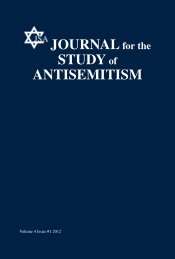JOURNALfor the STUDYof ANTISEMITISM
JOURNALfor the STUDYof ANTISEMITISM
JOURNALfor the STUDYof ANTISEMITISM
You also want an ePaper? Increase the reach of your titles
YUMPU automatically turns print PDFs into web optimized ePapers that Google loves.
290 JOURNAL FOR THE STUDY OF <strong>ANTISEMITISM</strong> [ VOL. 3:289<br />
minds of <strong>the</strong> perpetrators to be disposed to taking <strong>the</strong> extra step toward<br />
genocide if ever <strong>the</strong> conditions should call for it.<br />
While this latter situation did not occur in Russia, <strong>the</strong> destruction that<br />
rained down on Jewish communities at <strong>the</strong> end of <strong>the</strong> nineteenth and <strong>the</strong><br />
start of <strong>the</strong> twentieth centuries was no less horrifying for <strong>the</strong> Jewish communities<br />
and individuals who suffered. The formula attributed to <strong>the</strong> conservative<br />
Russian statesman Konstantin Pobedonostsev (1827-1907)—that<br />
<strong>the</strong> solution to Russian’s Jewish problem would be for one third to die, one<br />
third to assimilate, and one third to emigrate—found expression in <strong>the</strong><br />
pogroms: certainly <strong>the</strong>re were deaths, certainly <strong>the</strong>re were those who sought<br />
sanctuary through merging into <strong>the</strong> general population (difficult though that<br />
was), and certainly <strong>the</strong>re was intimidation, leading many Jews to flee<br />
overseas.<br />
This book examines <strong>the</strong> phenomenon of <strong>the</strong> pogrom and its effects,<br />
seen through a new lens and asking by <strong>the</strong> asking of new questions. The<br />
story of <strong>the</strong> pogroms is essentially connected to <strong>the</strong> Jews of Russia, though<br />
<strong>the</strong> pogrom as a device for terrorizing Jews and attaining antisemitic policy<br />
goals spread throughout eastern Europe in <strong>the</strong> latter part of <strong>the</strong> nineteenth<br />
century. This book, which comprises a number of articles originally<br />
presented as papers at an academic conference on <strong>the</strong> subject held in Stockholm,<br />
Sweden, in May 2005, examines <strong>the</strong> pogrom not only in <strong>the</strong> late<br />
Russian Empire, <strong>the</strong> Revolutionary period, and <strong>the</strong> early Soviet Union, but<br />
also localizes <strong>the</strong> phenomenon through considered studies of Ukraine,<br />
Poland, Lithuania, Siberia, and Belorussia.<br />
While <strong>the</strong> various essays all bring <strong>the</strong>ir own distinctive perspectives on<br />
pogroms to <strong>the</strong> table, <strong>the</strong> Introduction by <strong>the</strong> editors provides a very useful<br />
unifying structure to <strong>the</strong> volume overall. A brief consideration of <strong>the</strong> nature<br />
of anti-Jewish violence as a general <strong>the</strong>me in European history gives way to<br />
a definitional discussion concerning <strong>the</strong> notion of <strong>the</strong> pogrom itself: what it<br />
was, how it varied from place to place, and what its intentions were. A<br />
conclusion worthy of note is that while <strong>the</strong> pogroms stimulated a considerable<br />
outcry from foreign observers, and a resultant sympathy for <strong>the</strong> persecuted<br />
Jews, this did not lead to any form of concrete action to alleviate <strong>the</strong>ir<br />
distress.<br />
An additional point made in <strong>the</strong> Introduction—for some readers no<br />
doubt an obvious one, for o<strong>the</strong>rs perhaps not so obvious—is that <strong>the</strong><br />
pogroms have been largely overshadowed historically by <strong>the</strong> far greater<br />
antisemitic explosion that took place a generation later under <strong>the</strong> Nazis, <strong>the</strong><br />
Holocaust. It should not be held, though, that <strong>the</strong>se were necessarily two<br />
distinct experiences. The precedents offered in Russia were noted by many<br />
in Germany and elsewhere, and <strong>the</strong> political, social, and psychological uses<br />
that could be made of anti-Jewish violence were studied carefully by Euro-














